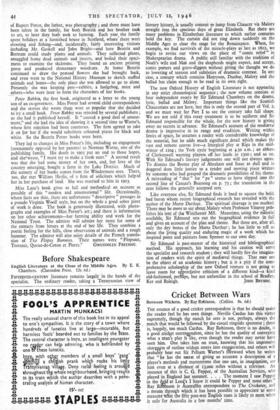Before Shakespeare
English Literature at the Close of the Middle Ages. By E. K. Chambers. (Clarendon Press. 12s. 6d.) FIFTEENTH-CENTURY literature remains largely in the hands of the specialist. The ordinary reader, taking a Tennysonian view of literary history, is usually content to jump from Chaucer via Malory straight into the spacious days of great Elizabeth. But there are many problems in Elizabethan literature to which earlier centuries hold the key. The curtain did not ring down suddenly on the Middle Ages to clear the stage for the Renaissance. When, for example, we find survivals of the miracle-plays as late as 1612, we begin to revise our views on the place of " comic relief " Shakespearian drama. A public still familiar with the tradition of Noah's wife and Mak and the shepherds might expect, and accept, comic porters and grave-diggers without giving the thought we do to lowering of tension and subtleties of dramatic contrast. In any case, a century which contains Henryson, Dunbar, Malory and the ballad has claim enough to be read in its own right.
The new Oxford History of English Literature is not appearing in any strict chronological sequence ; the new volume consists of four independent essays by Sir Edmund Chambers on the drama, lyric, ballad and Malory. Important things like the Scottish Chaucerians are not here, but this is only the second part of Vol. 2, and we must wait for Part I to see the century take full shape. We are not told if this essay treatment is to be uniform and Sir Edmund responsible for the whole, for the new history is giving away no secrets in advance. Sir Edmund's account of the mediaeval drama is impressive in its range and erudition. Writing within limits of space, he assumes a reader with considerable knowledge of the material, but he adds much significant detail which makes the vast and remote canvas live—a liturgical play at Riga in the mid- winter of 12o4 ; the York cycle beginning at 4.3o a.m. ; an abbess of Clerkenwell warning players off her lands in 13oo and so on. With Sir Edmund's literary judgements one will not always agree. To dismiss the Brome play of Abraham and Isaac as dull and in doggerel does little justice to a tender and moving piece written by someone who had grasped the dramatic possibilities of his theme. A misreading of " that " for " pa " seems to have slipped into the second line of Canute's Boatsong on p. 73 ; the translation in the note follows the generally accepted text.
Like everyone else, Sir Edmund finds it hard to square the bold, bad baron whom recent biographical research has revealed with the author of the Morte Darthur. The spiritual cleavage is too marked. There may be more to say about Malory when. Professor Vinaver pub- lishes his text of the Winchester MS. Meantime, using the material available, Sir Edmund sets out the biographical evidence in full and gives an account of the plan and theme. But these are, after all, only the dry bones of the Morte Darthur ; he has little to tell us about the living quality and enduring magic of a work which has inspired poets and painters from Spenser to our own day.
Sir Edmund is past-master of the historical and bibliographical method. His approach, his learning and his caution will serve the specialist and research student ; they will hardly fire the imagina- tion of readers with the spirit of mediaeval things. That may nor
be the object of an academic history; it is a pity if the com- prehensive scholarship of the new Oxford venture is not going to leave room for 4preciative criticism of a different kind—a 'kind old-fashioned, perhIps, but not unfamiliar in the school of Bradley,






























 Previous page
Previous page